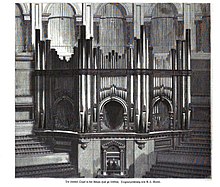Royal Albert Hall organ
The organ in the Royal Albert Hall in London after the Great Organ of the Cathedral of Liverpool 's second largest pipe organ in the United Kingdom . It was originally built by Henry "Father" Willis and was last reorganized from 2002 to 2004 by John Mander . Since then it has had 147 registers and 9999 pipes.
Willis organ
The original organ was built by Henry Willis & Sons in 1871. It had four manuals , 111 registers and was the largest in the world at the time.
Conversions and extensions by Harrison & Harrison
The Durham company Harrison & Harrison rebuilt the organ in two steps in 1924 and 1933, in which they expanded it to 146 registers (including three percussion registers) and installed an electro-pneumatic action . It was still the largest organ in Britain at the time. The 2014 Pink Floyd album The Endless River contains the track Autumn '68 with a recording by band member Richard Wright, who played the organ in 1969.
In the 1970s, Harrison & Harrison renovated the game cabinet and replaced the registration system, made minor changes to the intonation and added a roof to try to direct the sound forward, which was unsuccessful. Composer Wendy Carlos introduced the organ during the final title sequence of the 1982 Disney science fiction film Tron , performed by organist Martin Neary.
At the end of the 20th century the organ was again in poor condition. More and more registers were unusable due to leaks in the wind system, cracks in the wind chests and other problems. The wind escaped noisily from wind tunnels and wind shops, the wind supply was insufficient for a full game. The leather parts of the action were also leaking. Until 2002 the organ was only kept playable through "heroic efforts" by Harrison & Harrison and could only be used in the presence of organ builders in the event of a malfunction.
Repair and reconstruction by Mander
In 2002 the organ was taken out of service for extensive renovation by John Mander, owner of the Mander Organs company. Consideration was given to restoring the original Willis disposition; but the subsequent changes and enlargements had made this impractical, and it was felt that it should essentially remain as it is.
The drought in the hall had damaged the wind chests, so they were replaced and new and larger wind tunnels were built. The roof was removed and the tongue registers in the Great Division were reset to their 1924 wind pressure. The division of the Great Organ in the 1970s (which made it possible to register two independent Great Organs at the same time and play them in different manuals) was streamlined and effectively provided separate register groups from Willis and Harrison & Harrison. A fitting IV has also been added. The disposition now comprised a total of 147 registers and 9999 sounding pipes. For a few years the organ was again the largest in Great Britain, until that title was passed on to the organ in Liverpool's Anglican Cathedral (10,268 pipes) in 2007.
The organ was inaugurated again on the evening of June 26, 2004 at a gala concert with David Briggs, John Scott and Thomas Trotter with the Royal Philharmonic Orchestra under Richard Hickox . The instrument played a prominent role at the 2004 BBC Proms . The first recordings on the newly rebuilt instrument were made by Gillian Weir . The instrument was also used by the progressive rock band Muse when they played megalomania , which was originally recorded on another Willis organ, in Saint Mary's Church in Bathwick.
Disposition
The current disposition after the renovation of Mander in 2004 is as follows:
|
|
|
|||||||||||||||||||||||||||||||||||||||||||||||||||||||||||||||||||||||||||||||||||||||||||||||||||||||||||||||||||||||||||||||||||||||||||||||||||||||||||||||||||||||||||||||||||||||||||||||||||||||||||||||||||||||||||||||||||||||||||||||||||||||||||||||||||||||||||||||||||||||||||||||||||||||||||||||||||||||||||||||||||||||||||||||||||||||||||||||||||||||||||||||||||||||||||||||||||||||||||||||||||||||||||||||||||||||||||||||||||||||||||||||||||||||||||||||||||||||||
- Coupling : Choir to Pedal, Great to Pedal, Swell to Pedal, Solo to Pedal, Choir (unenclosed) on Solo, Octave Orchestral, Sub Octave Second Division (Orchestral), Unison off, Swell to Choir, Solo to Choir, Reeds on Choir , Great Second Division on Choir,Choir to Great, Swell to Great, Solo to Great Octave (only 16 ′, 8 ′, 4 ′) , Solo to Swell, Octave, Sub Octave, Unison off, Octave Bombard (16 ′, 8 ′, 4 ′ stops only) , Bombard on Choir, Tubas on Choir
- Remarks
Individual evidence
- ^ Molloy Woodcraft: Pink Floyd: The Endless River review - 'a good way to call it a day' . In: The Observer . November 9, 2014. Retrieved December 10, 2014.
- ↑ NME News Desk: Pink Floyd producer says Royal Albert Hall organ solo used on new album was 'moment of rebellion' . In: NME . September 26, 2014. Retrieved December 10, 2014.
- ↑ Details of the organ in the National Pipe Organ Register , accessed on July 16, 2020 (English)

